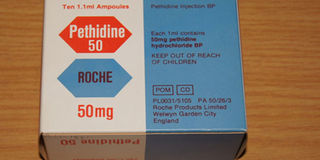Pethidine good pain relief drug

Pethidine is used to relieve moderate to severe pain. It is commonly administered through injection. file photo
What you need to know:
Those who have undergone surgery are also advised to use the drug with caution because it is metabolised in the body to a by-product which accumulates, especially where the kidneys are malfunctioning. This by-product is said to be associated with eventual convulsions
Pethidine is considered one of the best painkillers. Women can use it during labour, although other drugs in this category, called opioids may also be administered to ease obstetric pain.
On the other hand, morphine, which is catergorised in the same class as pethidine may also be used to manage obstetric pain. However, pethidine causes less constipation compared to morphine. Pethidine produces prompt and short-term pain relief (analgesia), and is not recommended for people who have severe, long running pain.
Those who have undergone surgery are also advised to use the drug with caution because it is metabolised in the body to a by-product which accumulates, especially where the kidneys are malfunctioning. This by-product is said to be associated with eventual convulsions.
People who have impaired respiratory function and low blood pressure are also advised to take caution while using the drug. Pethidine can also be used to manage dental pain. Although it may be taken orally, in this case it is best administered through an injection.
Some of the side effects of using the drug include nausea and vomiting. In some cases, it may cause drowsiness, and therefore affect performance of skilled acts such as driving. The effects of alcohol are also enhanced when a person takes pethidine.
Like most drugs, pethidine is prone to abuse as it is often associated with euphoria (feelings of happiness). It is, however, unlikely that when a person takes the medicine occasionally, they will become dependent on it to manage any kind of pain. The dosage for pethidine varies.
A 50 to 150 milligramme should be administered every four hours to people with acute pain. The dosage for children depends on their weight. Ultimately, though, the doctor or pharmacist will decide how much dose a person requires.
The writer is a pharmacist




